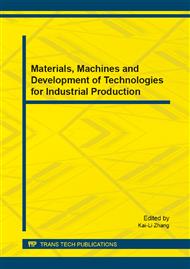[1]
D. Branton, D. W. Deamer, A. Marziali, H. Bayley, S. A. Benner, T. Butler, M. Di Ventra, S. Garaj, A. Hibbs, and X. Huang, The potential and challenges of nanopore sequencing, Nat. Biotechnol. 26(2008)1146-1153.
DOI: 10.1038/nbt.1495
Google Scholar
[2]
N. Arjmandi, W. Van Roy, L. Lagae, and G. Borghs, Measuring the electric charge and zeta potential of nanometer-sized objects using pyramidal-shaped nanopores, Anal. Chem. 84(2012)8490-6.
DOI: 10.1021/ac300705z
Google Scholar
[3]
J. Hurley, Sizing particles with a Coulter counter, Biophys. J. 10(1970)74-79.
Google Scholar
[4]
K. J. Freedman, M. Jürgens, A. Prabhu, C. W. Ahn, P. Jemth, J. B. Edel, and M. J. Kim, Chemical, thermal, and electric field induced unfolding of single protein molecules studied using nanopores, Anal. Chem. 83(2011)5137-5144.
DOI: 10.1021/ac2001725
Google Scholar
[5]
B. M. Venkatesan and R. Bashir, Nanopore sensors for nucleic acid analysis, Nat. Nanotechnol. 6(2011)615-624.
Google Scholar
[6]
K. N. Sugahara, T. Teesalu, P. P. Karmali, V. R. Kotamraju, L. Agemy, O. M. Girard, D. Hanahan, R. F. Mattrey, and E. Ruoslahti, Tissue-penetrating delivery of compounds and nanoparticles into tumors, Cancer cell. 16(2009)510-520.
DOI: 10.1016/j.ccr.2009.10.013
Google Scholar
[7]
M. Tsutsui, S. Hongo, Y. He, M. Taniguchi, N. Gemma, and T. Kawai, Single-nanoparticle detection using a low-aspect-ratio pore, ACS nano. 6(2012)3499-3505.
DOI: 10.1021/nn300530b
Google Scholar
[8]
A. Storm, J. Chen, X. Ling, H. Zandbergen, and C. Dekker, Fabrication of solid-state nanopores with single-nanometre precision, Nat. Mater. 2(2003)537-540.
DOI: 10.1038/nmat941
Google Scholar
[9]
K. H. Lee, X. Y. Lim, K. W. Wai, F. Romanato, and C. C. Wong, Variation of Nanopore Diameter Along Porous Anodic Alumina Channels by Multi-Step Anodization, J. Nano. Sci. Nano. Techno. 11(2011)1147-1153.
DOI: 10.1166/jnn.2011.3097
Google Scholar
[10]
S. Ng, H. Wong, H. Lau, and C. Leung, Large-Area Anodized Alumina Nanopore Arrays Assisted by Soft Ultraviolet Nanoimprint Prepatterning, J. Nano. Sci. Nano. Techno. 12(2012)6315-6320.
DOI: 10.1166/jnn.2012.6440
Google Scholar
[11]
L. X. Zhang, S. L. Cai, Y. B. Zheng, X. H. Cao, and Y. Q. Li, Smart Homopolymer Modification to Single Glass Conical Nanopore Channels: Dual‐Stimuli‐Actuated Highly Efficient Ion Gating, Adv. Funct. Mater. 21(2011)2103-2107.
DOI: 10.1002/adfm.201002627
Google Scholar
[12]
K. Zhou, L. Li, Z. Tan, A. Zlotnick, and S. C. Jacobson, Characterization of hepatitis B virus capsids by resistive-pulse sensing, J. Am. Chem. 133(2011)1618-1621.
DOI: 10.1021/ja108228x
Google Scholar
[13]
J. Li, D. Stein, C. McMullan, D. Branton, M. J. Aziz, and J. A. Golovchenko, Ion-beam sculpting at nanometre length scales, Nat. 412(2001)166-169.
DOI: 10.1038/35084037
Google Scholar
[14]
L. P. Liu, H. W. Wu, Y. Xuan, X. J. Wang, Y. Zhang, Y. W. Chen, and Q. J. Liu, Study on the size shrinking and shape changing of solid-state nanopores, Adv. Mater. Res. 189(2011)3218-3221.
DOI: 10.4028/www.scientific.net/amr.189-193.3218
Google Scholar
[15]
W. -J. Lan, D. A. Holden, B. Zhang, and H. S. White, Nanoparticle transport in conical-shaped nanopores, Anal. Chem. 83(2011)3840-3847.
DOI: 10.1021/ac200312n
Google Scholar
[16]
R. Wei, V. Gatterdam, R. Wieneke, R. Tampé, and U. Rant, Stochastic sensing of proteins with receptor-modified solid-state nanopores, Nat. Nanotechnol. 7(2012)257-263.
DOI: 10.1038/nnano.2012.24
Google Scholar
[17]
P. Chen, J. Gu, E. Brandin, Y. -R. Kim, Q. Wang, and D. Branton, Probing single DNA molecule transport using fabricated nanopores, Nano. Lett. 4(2004)2293-2298.
DOI: 10.1021/nl048654j
Google Scholar


